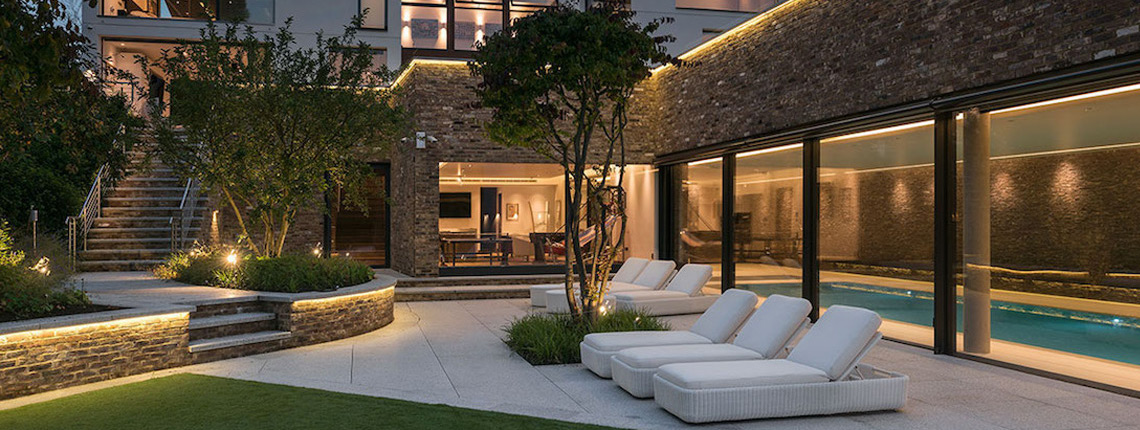

As the nights draw in, this is a great time to think about garden lighting. But why light your garden, and what makes a great garden lighting design? Here’s our step by step guide for great garden lighting.
There are several benefits of great lighting in your garden. Security and safety are at the top of this list. It can help highlight trip hazards, aid navigation or pathfinding. And of course light enables you to enjoy your garden for longer, especially during the winter months. An often overlooked reason is that it helps to bring the ‘outside in’, providing a view out, and preventing windows turning into large black mirrors at night.
A little light goes a long way and less is certainly more. You don’t need to light your lawn to the same level as Wembley stadium and your garden path isn’t a runway at Heathrow Airport. It’s also important to think about the setting. A garden in central London requires a very different approach to a landscape out in the country side. We look to use the minimum amount, and the most energy efficient light fittings, only using light where it’s needed. At the lighting design studio we believe in treating light sparingly like a precious commodity.
Start with task lighting and determine where you actually need light. How will the space be used? Do driveways, pathways, steps or trip hazards need light? Are there any BBQ areas, patios, outside dining spaces, play areas, hot tubs or even tennis courts? If the answer is yes, decide if direct or diffused light is needed, perhaps a combination, then find appropriate light fittings for each area.
Spike lights, low level wall lights, in ground fittings, lamp posts, bollards, wall mounted spot lights, flood lights, lanterns, lighting festoons, LED tape and fairy lights (we’re big fans of fairy lights at the lighting design studio they’re not just for Christmas!) are all useful. It’s important to remember that garden light fittings are exposed to the elements, and poor quality fittings won’t last. The market is flooded with poor quality light fittings. With good quality LED’s lasting over 50,000 hours, we use products that are designed for longevity. We put an emphasis on specifying products that can be maintained, repaired and recycled. You can see our 5 best light fittings for your garden here.
Choose some key features or focal points such as trees, planting, architecture or water features and highlight these with light. Textures are key, foliage, water, brick and stone all have unique characteristics and lighting can be a powerful tool for showcasing these elements. Accent lighting layered together is what makes for stunning and magical exterior lighting schemes, but remember shadows are just as important as light. Many Plants offer brilliant opportunities for creating drama and patterns with shadows.
It’s at this point, if it’s a particularly beautiful building and in an appropriate setting, you should consider lighting to the building facade. Also think about the entrance to your property. Lighting plays a fundamental role when it comes to setting first impressions.
It’s important to consider security. Are there any particularly dark areas or points of access at risk of being vulnerable. Do you need to allow flood lighting around buildings that switches on when movement is detected?
Finally you need to consider control. How do you turn on these lights? You really don’t need anything complicated and it’s best to keep the number of lighting circuits to a minimum. Often only 2 ‘light scenes’ are required, one for when you’re inside and not actually in the garden, helping to provide a view out. The second for when you’re outside. Often 2 or 3 lighting circuits is plenty. Just make sure the task and accent lights are on separate circuits. You also need to decided if these circuits are simply switched on and off via a light switch, a lighting control system or perhaps a time clock, dusk till dawn sensor, or presence detector (PIR).
You need to think about colour temperature. The warmth or coolness of light is described by colour temperature and measured in Kelvin. You can read much more about this here. When using LEDs in your garden it’s important to choose warm white LED’s and make sure different types of light match each other.
Next there’s colour rendering. Not all light sources are made equal because artificial light does not emit a balanced mixture of all colours. CRI is a measurement showing how light affects the appearance of colour and every light has its place on the colour rendering index you can find out more about this here. In general you want lights with a CRI of 90 or better.
It’s important to consider flexibility from the outset. Plants and trees grow and change with the seasons, so spike lights are a great choice offering flexibility.
Fittings should blend into the landscape, so finish of light fitting is important. Green or black is often most appropriate, but copper is also a favourite as it patinas over time.
Generally minor domestic light fittings are not subject to planning controls, but this is not always the case. It’s worth checking with your local council or building control officer to see if there are any restrictions or limitations.
Light trespass (where light enters neighbouring properties) can cause big issues and needs to be a consideration when locating every light source.
Minimising light pollution is super important to help protect habitats for bats, moths and a whole host of insects important to biodiversity.
If you’re thinking of installing or upgrading lighting in a garden, don’t do anything until you’ve checked out these 3 common mistakes that people make.
If you would like any help lighting a landscape or garden then please do feel free to get in touch for a free 30 minute consultation.